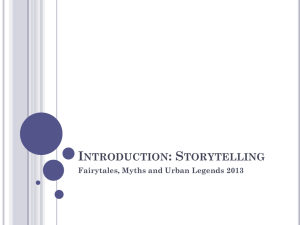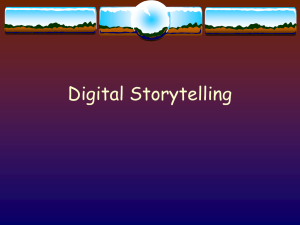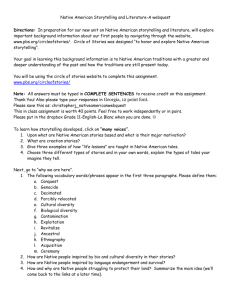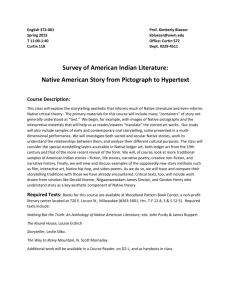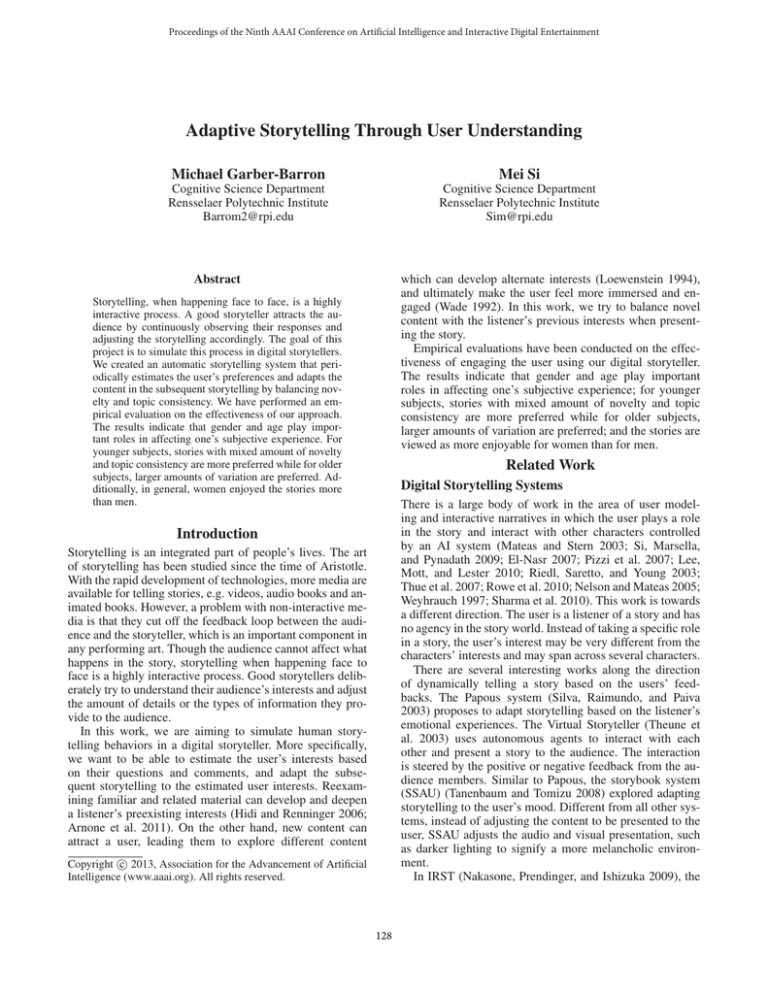
Proceedings of the Ninth AAAI Conference on Artificial Intelligence and Interactive Digital Entertainment
Adaptive Storytelling Through User Understanding
Michael Garber-Barron
Mei Si
Cognitive Science Department
Rensselaer Polytechnic Institute
Barrom2@rpi.edu
Cognitive Science Department
Rensselaer Polytechnic Institute
Sim@rpi.edu
Abstract
which can develop alternate interests (Loewenstein 1994),
and ultimately make the user feel more immersed and engaged (Wade 1992). In this work, we try to balance novel
content with the listener’s previous interests when presenting the story.
Empirical evaluations have been conducted on the effectiveness of engaging the user using our digital storyteller.
The results indicate that gender and age play important
roles in affecting one’s subjective experience; for younger
subjects, stories with mixed amount of novelty and topic
consistency are more preferred while for older subjects,
larger amounts of variation are preferred; and the stories are
viewed as more enjoyable for women than for men.
Storytelling, when happening face to face, is a highly
interactive process. A good storyteller attracts the audience by continuously observing their responses and
adjusting the storytelling accordingly. The goal of this
project is to simulate this process in digital storytellers.
We created an automatic storytelling system that periodically estimates the user’s preferences and adapts the
content in the subsequent storytelling by balancing novelty and topic consistency. We have performed an empirical evaluation on the effectiveness of our approach.
The results indicate that gender and age play important roles in affecting one’s subjective experience. For
younger subjects, stories with mixed amount of novelty
and topic consistency are more preferred while for older
subjects, larger amounts of variation are preferred. Additionally, in general, women enjoyed the stories more
than men.
Related Work
Digital Storytelling Systems
There is a large body of work in the area of user modeling and interactive narratives in which the user plays a role
in the story and interact with other characters controlled
by an AI system (Mateas and Stern 2003; Si, Marsella,
and Pynadath 2009; El-Nasr 2007; Pizzi et al. 2007; Lee,
Mott, and Lester 2010; Riedl, Saretto, and Young 2003;
Thue et al. 2007; Rowe et al. 2010; Nelson and Mateas 2005;
Weyhrauch 1997; Sharma et al. 2010). This work is towards
a different direction. The user is a listener of a story and has
no agency in the story world. Instead of taking a specific role
in a story, the user’s interest may be very different from the
characters’ interests and may span across several characters.
There are several interesting works along the direction
of dynamically telling a story based on the users’ feedbacks. The Papous system (Silva, Raimundo, and Paiva
2003) proposes to adapt storytelling based on the listener’s
emotional experiences. The Virtual Storyteller (Theune et
al. 2003) uses autonomous agents to interact with each
other and present a story to the audience. The interaction
is steered by the positive or negative feedback from the audience members. Similar to Papous, the storybook system
(SSAU) (Tanenbaum and Tomizu 2008) explored adapting
storytelling to the user’s mood. Different from all other systems, instead of adjusting the content to be presented to the
user, SSAU adjusts the audio and visual presentation, such
as darker lighting to signify a more melancholic environment.
In IRST (Nakasone, Prendinger, and Ishizuka 2009), the
Introduction
Storytelling is an integrated part of people’s lives. The art
of storytelling has been studied since the time of Aristotle.
With the rapid development of technologies, more media are
available for telling stories, e.g. videos, audio books and animated books. However, a problem with non-interactive media is that they cut off the feedback loop between the audience and the storyteller, which is an important component in
any performing art. Though the audience cannot affect what
happens in the story, storytelling when happening face to
face is a highly interactive process. Good storytellers deliberately try to understand their audience’s interests and adjust
the amount of details or the types of information they provide to the audience.
In this work, we are aiming to simulate human storytelling behaviors in a digital storyteller. More specifically,
we want to be able to estimate the user’s interests based
on their questions and comments, and adapt the subsequent storytelling to the estimated user interests. Reexamining familiar and related material can develop and deepen
a listener’s preexisting interests (Hidi and Renninger 2006;
Arnone et al. 2011). On the other hand, new content can
attract a user, leading them to explore different content
c 2013, Association for the Advancement of Artificial
Copyright Intelligence (www.aaai.org). All rights reserved.
128
story is developed around the notion of interest. A fixed story
is presented to the user, but optional information can be presented to add details about characters or events. As the user
views the scenes they can explicitly demonstrate their interest through an adjustable slider, which is used to indicate
which characters interest the user.
Our work is inspired by IRST. We also try to adapt a
story around the interests and preferences of the user. In this
work, we go further by trying to balance between providing the user more material along the lines of where he/she
has already shown interest and presenting materials that can
potentially trigger new interest from the user. In addition,
we also developed algorithms for automatically inferring the
user’s interest from his/her questions and comments.
Curiosity and Interest of the Audience
From a psychological perspective, curiosity have been
viewed purely in terms of a need for environmental variation, and novel stimuli (Loewenstein 1994). This later extended to include a more directed view in that the interest and curiosity of an individual can be comprised of a
desire for particular knowledge, or information (Berlyne
1954). In general, there is an acceptance of associating interest in relation to exploring information that is novel, or
causes uncertainty (Reeve and Nix 1997; Loewenstein 1994;
Day 1982).
More recently, Arnone et al. has proposed a functional
definition where interest and curiosity are viewed as mediating factors towards the development of user engagement (Arnone et al. 2011). As our preference for particular content develops, we examine related material and information pertaining to those interests. Certain content that
initially sparks the user’s curiosity can be further explored
leading to a deeper sense of interest (Hidi and Renninger
2006). This in turn can lead to a greater degree of immersion and engagement with the content. In contrast, failing to
effectively address the user’s interests may lead to a sense of
withdrawal and boredom (Arnone et al. 2011).
Figure 1: User Interface for Evaluation
ments to direct towards the storyteller. A snapshot of how we
present the story and the user’s options is shown in Figure 1.
Automated Storytelling System
We want to engage the user by letting him/her hearing more
about the type of content they’ve already shown interest towards as well as to discover new interests. To realize this
goal, our system is comprised of two components: an interest profiling module that is used to infer what aspects of the
story interest the user and an event selection module which
tells the story. The event selection module determines the
content to present to the user after taking into account his/her
interests and the progression of the story.
Example Domain
Our example domain is a Chinese fantasy story – “The
Painted Skin” (Sung-Ling 1916). The story starts as a young
man – Wang – meets an attractive young lady on the road.
She was actually a demon, and she approached young men
like Wang in order to obtain energy from them. Wang will
eventually die when his energy is drained. However, Wang
did not know this, and quite enjoyed the demon’s company
until one day he met a priest on the street who warned him
about the demon. The story continues with the demon accidentally revealing her true identity to Wang, killing Wang,
and the priest helping Wang’s family to defeat the demon
and resurrect Wang.
We created two versions of the story. One is a 3D interactive environment created in the Unity game engine. The
other is a text version with associated pictures. For the purpose of conducting our evaluation as an online survey, the
text version was utilized. In both representations, as the
story progresses, the user selects various opinionated state-
Story Representation
We represent a story as a set of connected events. Each
event is either a phyical event that progresses the story
or an informational event that describes the characters’
background, beliefs, or motivations. Both kinds of events
are mapped to a line of text that is displayed or spoken
by the narrator. Similar to other interactive narrative work
that use a graph of plot-points (Nelson and Mateas 2005;
Weyhrauch 1997), to ensure that the story can only progresses in a logical and coherent manner, events are modeled with preconditions, which are defined as a combination
of events that should or should not have already happened
in the story. Further, while both physical and informational
events are treated algorithmically the same, in the case of
physical events, they are structured to progress in the same
relative order. In contrast, informational events can appear
variably and optionally in terms of presentation. For exam-
129
ues can either be randomly assigned or set by the designer.
These values are adjusted as the user makes more choices.
These preference values determine the impact that each profile will have during the Event Selection.
ple, in our story, both the physical event of Wang meeting
the demon and his meeting of the priest will always occur
in the story, and in that order of occurrence. However, an informational event such as Wang discussing his attitude about
the demon may optionally occur, but, it can only appear after
Wang’s meeting with the demon.
For enabling our system to understand the progression of
the story and the user’s interests, the events described by the
narrator and the statements the user can say to the narrator
are tagged with labels. For example, the event “Wang hoped
that the priest could find some way of protecting his family” is labeled with [Wife, Fear, Love, Wang]. The labels are
determined by the designer of the interactive story. For modeling the “Painted Skin” story, twenty-four labels were used.
Profile Update Procedure
The profiles are updated as the story progresses based on
the choices of the user. When the user selects a statement
it is compared to each profile, and used to update the most
similar profile, which is determined by comparing the labels of the statement with the label values in each profile.
Specifically, the Euclidean distance between the two profile
arrays are used, and the profile with the smallest distance
to the statement is selected as the most similar profile. The
score of this profile is then incremented to indicate that the
system views the profile as relatively more representative of
the user’s interests. After this, the label values within this
profile are updated by calculating the average occurrence of
each label relative to the number of times the profile has been
chosen by the system (see (Garber-Barron and Si 2012) for
details). This way, labels that are persistently chosen are valued more highly.
Interest Profiles
In our system, the user’s interests are represented as a vector of interest profiles. Each profile is a distinct representation of the user’s inferred interest towards the various labels the designer used for modeling the story. More specifically, each profile includes a vector of values that specify the
user’s inferred interest towards each of the labels, for example: [Wife: 0.4, Fear: 0.3, Love: 0.2, Wang: 0.1].
A profile can be thought of as a distribution of the user’s
disposition towards the labels and the associated events. The
objective of developing multiple profiles is to distinguish between possible focuses of interest based on limited input.
For example, as the story is progressing, the user has demonstrated a high preference towards both content labeled with
“Love” and “Fear”. However, the user has not shown an interest towards contents that contain both labels. To account
for this difference, we need at least two different profiles.
One profile has a large preference value for “Love”, and the
other has a large preference value for “Fear”. Then, when the
system is trying to determine new content to present, events
with the dual labels of “Love” and “Fear” will be considered
less interesting to the user over events that only contain one
of the labels. The more profiles there are, the more fine distinctions the system can make about the user’s interests. Of
course, this brings up the question of the necessary number
of different profiles. Our proposed algorithms for event selection and profile update will operate in the same fashion as
long as there is more than one profile. The exact number of
profiles is determined by the designer. For a short story like
this, we set the number as two.
The initial values of the labels in each profile can either
be set by the designer or by default configured randomly,
which indicates that the system has no prior knowledge of
the user’s interests. These profiles are updated as the user
makes choices in the storytelling process, and the system
gets additional information about the user’s preferences. The
more the user interacts with the system, the more likely the
profiles will converge and reflect the user’s true interests.
As the user selects statements, the system calculates confidence/preference values associated with each of the user
profiles. These values indicate how closely each profile is
representative of the user’s interests so far. Similar to the
values of the labels in each profile, the initial preference val-
Event Selection
Algorithm 1 details how the system selects the next informational or physical event to be presented to the user. An
overall score is generated for each event that can immediately proceed (judged by their preconditions) in the story.
These scores are estimates for how the events will interest
the user immediately, as well as lead to future content and
events that will continue to engage the user.
In order to generate these scores and determine which
event to present to the user, Algorithm 1 is applied to determine what to select. The scores for each event are calculated
by using a weighted sum of the user’s inferred preference
towards each interest profile along with the profile scores
and consistency values the system had generated in Algorithm 2 (see Algorithm 1, Line 6 and Line 8) which consider
both the topic’s novelty and consistency.
Once a score for each event is calculated, the system
chooses the event with the highest calculated score to
present to the user. The overall score for each event (Algorithm 1, Line 8) represents a combined measure of how
well each event fits the profiles of the user (their preferences
and interests), the consistency of the topics of interest that
can appear in relation to that event, and the degree of novel
and new labels that can potentially stem from it. In doing so,
we are acknowledging the perceived importance for the system of each profile, and the notions of interest, novelty, and
the consistency of those interests. Algorithm 2 details the
process of how the system evaluates each individual event.
Events are scored by determining the event trajectories that
can follow them in the story – a sequence of events through
the story that best account for the user’s interests. This is
done by recursively exploring the various branching paths
through the story stemming from each possible event.
A trajectory generates a cumulative score that accounts
for how likely the system believes each of the possible sequences of events will engage the user while accounting for
novelty and topic consistency. Both the original event and
130
Algorithm 1 EventSelection(EventOptions, P rof iles)
Algorithm 2 EventEvaluation(OriginalEvent, N extEvent,
1: #AvgStoryP ath: The average length to traverse through a
story
2: #P ref erences: An array containing the inferred user preference towards each profile
3: P ref erences = Normalize(P ref erences)
4: #P rof ileScore, Consistency: Arrays with all their elements initialized to zero
5: for each Event in EventOptions do
6:
P rof ileScore, Consistency =
EventEvaluation(Event, Event, P rof ileScore,
Consistency, P rof iles)
7:
for each P rof ile in P rof iles do
8:
EventScore+=
P ref erences[P rof ile] ∗ P rof ileScore[P rof ile]∗
((Consistency[P rof ile])/AvgStoryP ath)
9:
if EventScore > P ref erredScore then
10:
P ref erredEvent = Event
11:
P ref erredScore = EventScore
12: Return P ref erredEvent
P rof ileConsistency, P rof ileScore, P rof iles)
1: #P rof ileConsistency: An array containing the average
number of events that are traveled in succession pertaining to
each profile
2: #P rof ileScore: An array containing the calculated scores for
OriginalEvent as it pertains to each profile
3: F utureEvents = GetFutureEvents(N extEvent)
4: #M axDepth: The maximum depth that events can still be
evaluated
5: if F utureEvents is Empty or at Max Depth then
6:
Return P rof ileConsistency, P rof ileScore
7: for each Event in F utureEvents do
8:
P rof ile = GetClosest(P rof iles, Event)
9:
P reviousP rof ile =
GetClosest(P rof iles, N extEvent)
10:
Distance = GetDistance(P rof ile, Event)
11:
rof ile]+=
P rof ileScore[P
1 − LengthOf P ath − Distance
M axP athLength
12:
if P reviousP rof ile = P rof ile then
13:
P rof ileConsistency[P rof ile]+= 1
14:
EventEvaluation(OriginalEvent, Event,
P rof ileConsistency, P rof ileScore, P rof ile)
15: Return P rof ileConsistency, P rof ileScore
16:
17: #GetFutureEvents(Event): Returns a list of future
events that can directly follow Event
each of the subsequent events that can follow are compared
to the user’s profiles and summed in an attempt to contribute
to the original event’s overall score - an estimate of its perceived importance towards leading the user along an engaging story.
Importantly, the scores generated along these event trajectories are comprised of a sum of sub-scores that are equal
to the number of profiles. This allows the system to evaluate
the importance of an event to the user in relation to how well
it matches each profile, as well as all events that can causally
follow. By doing this, the system incorporates the relevance
of the immediate event and future content that can arise from
it in relation to all profiles of the user.
Consistency To prevent the oscillation between topics, the
current system emphasizes trajectories that fully explore one
topic – events in succession that are similar to one associated
profile and their corresponding label values – followed in
succession by alternative topics related to other profiles (see
Algorithm 2, Line 13). Events along a trajectory that are similar to the same profile in succession cause an increase in
the consistency value and thus the overall score. The generated value is later recombined with the novelty and interest
values when they are used to calculate the original event’s
score (Algorithm 1, Line 8).
Novelty When calculating the score of an event, novelty
is applied by increasing the impact of labels that occur less
frequently in the selection process. This is achieved by exploring possible future trajectories of events from the original and giving a greater weight in the scoring process to
less frequently occurring labels. As can be seen in Algorithm 2, Line 11, as future events are examined farther ahead
in the story, those that have fewer labels and topic similarity
will have an increasingly high positive impact on the overall
score of the event.
gate not only the overall hypothesis of whether the system
makes the storytelling process more engaging, but also how
the subcomponents of the system, i.e. keeping topic consistency, and incorporating novel content affect the user’s experiences.
Because of the nature of interactive storytelling, each user
of the system will hear a slightly different story based on
their responses, and the system’s estimation of what content
would best interest them. As such, these variations of the
story, though generated using the same algorithms, can lead
to fairly variable content in terms of informational events.
Instead, for this initial evaluation, we want to have a very
controlled study. Instead of having the subjects directly interact with the system, we manually simulated two different types of users interacting with the system, and showed
the histories of these interactions to the subjects. The subjects were asked about what they think of the (simulated)
users’ experiences of interacting with the system. Out of the
huge collection of possible user profiles, we picked two prototypical ones – one presenting a positive user and the other
presenting a negative user. They are described in the next
section.
Experimental Design
A 2 by 2 between subjects design was used. The first independent variable is storytelling style, i.e. whether the system
is responding to the user’s expressed interests while telling
the story. This independent variable has two levels: nonrandom (generating the story based on the estimated user interests) and random (generating the story based on a random
and fixed user profile). We expect the non-random condition
to be judged as more engaging because in this condition nov-
Evaluation
To evaluate how well our system can engage its users, a
preliminary evaluation was conducted. We want to investi-
131
elty and topic consistency are more balanced. In the random
condition, the system will introduce a large degree of variability as it does not algorithmically account for or balance
between novelty and topic consistency.
The second independent variable is the type of the user
that interacted with the system.We want to evaluate whether
our proposed storytelling algorithms work for different types
of users. In this preliminary evaluation, we test on two very
distinct user profiles. The positive user is modeled as having a preference for positive events and relationships such as
care, love, protection, etc. He/she will be more likely to select statements/questions such as: “Whoa, that is really nice
of Wang to do for her.” The negative user is modeled as having a preference for negative events and relationships such
as violence, deceit, lust, etc. He/she will be more likely to select statements/questions such as: “Wang broke his promise
pretty quickly, huh?” We do not have a specific hypothesis regarding the effect of the user’s interaction style on the
story’s engagement.
The dependent variables are the subjects’ rating of the following 5 items using a 7 points Likert scale:
the subjects 15 of the labels used in this story. They were
asked to rate how well each of the labels represented the
user’s interest using a 7 point Likert scale. We also collected
data on the subjects’ gender, age, and location.
Data Analysis and Results
There are five questions in the questionnaire. We first performed a Pearson’s bivariate correlation analysis, which indicates a high correlation among their answers (p<.01 for
all the comparisons). Therefore, we decided to perform a
MANOVA test instead of individual ANOVA tests. Further,
we suspected that in addition to the independent variables,
the subjects’ gender and age may influence their judgments.
Our MANOVA test has four independent variables which
are the storytelling style, user interaction type, gender and
age. The Roy’s Largest Root test was used for significance
testing.
The MANOVA test revealed a significant main effect
of gender (p<.01), female subjects consistently rated each
question higher than male subjects (M=0.21). Further, a
marginally significant main effect of age (p<.01), a significant interaction effect between storytelling style and
age (p<.01), a significant interaction effect between gender
and age (p<.01), a marginally significant interaction effect
between user type and age (p<.01), and a marginally significant interaction effect between storytelling style, gender and
age (p<.01) were observed.
This analysis is performed using SPSS, and the covariances among the dependent variables (the 5 questions) has
been taken into account.
Further, the tests of between-subjects effects indicates a
significant interaction effect between storytelling style and
age on [EN G N OV ] (p<.01) and [EN G SEL] (p<.05)
and a marginally significant interaction effect between gender and user type on [EN G SEL] (p<.05). For controlling
the overall type I error, we adjust α to .05/5 = .01 for these
tests. Figure 2 show the interaction effects.
• [EN G U SR]: Based on the user’s responses how engaging do you think the story was for the user?
• [REP IN T ]: What degree do you think the story was
representative of the user’s interests?
• [EN G CON ]: What degree do you think the story was
engaging for the user because it was consistent with the
user’s interest?
• [EN G N OV ]: What degree do you think the story was
engaging for the user because of the novelty of the content
presented?
• [EN G SEL]: How engaging did you find the story?
Procedure
We conducted this experiment as an anonymous survey on
Amazon’s Mechanical Turk. A total of 252 subjects participated in this study over four days’ time. 117 of them are
women and 132 are men. The subjects’ ages range from 19
to 61. For data analysis purpose, we partitioned subjects’
ages into four groups: 30 and below; 30 to 40; 40 to 50; and
50 and older. There are 82, 91, 39 and 39 subjects in each of
the groups respectively, and 3 subjects did not specify their
genders.
Each subject was randomly assigned to one of the four experimental conditions. In each condition, the subjects read
an interaction history consisting of 8 segments that were
generated using the corresponding story generation algorithms and user profiles. In each segment, as shown in Figure 1, a picture that represents the development of the story
is displayed, followed by the narrator’s description of the
story, the choices the user can pick from, the choice picked
by the user and the narrator’s response in sequence. The subjects are informed that the user’s choice not only affects the
narrator’s response, but also the subsequent descriptions of
the story.
At the end, the subjects were asked to rate the 5 items
listed in the previous section. In addition, we presented to
Figure 2: Interaction Effect Between Storytelling Style and
Age on [EN G SEL] and [EN G N OV ]
We can observe a common phenomenon that the age
groups below 40 and above 40 exhibit different, fairly contrasting behavioral patterns. As shown in Figure 2, there
are different trends of how the storytelling style affects the
subjects’ own experiences of engagement [EN G SEL] and
their expectation of the story being engaging to the user (listener) because of the novel content integrated into the story
132
[EN G N OV ]. For [EN G SEL], when the system considers the user’s input – the non-random condition, as age goes
up, the subjects found the story less engaging. The opposite happens when the storytelling does not account for the
user’s input – the random condition. As the subjects’ ages
increase, so did their sense of engagement with the random
condition. For [EN G N OV ], as the subjects’ ages increase,
the subjects tend to find the story more engaging because of
the novel content in it. Not surprisingly, when the story was
generated without considering the user’s input, this trend is
far greater.
In both figures in Figure 2, the subjects in the younger age
groups seem to behave more consistent with our primary hypothesis – we hypothesized that the story will be more engaging to the user if the user’s input is taken into consideration. To test this effect, we ran the same MANOVA again
with only the first two age groups, that is subjects who are
younger than 40. This time, the storytelling style becomes
a significant factor that affects [EN G N OV ] (p<0.05).
Though it does not affect other variables significantly, because of the very high correlation among the dependent variables, we take this as a positive sign of the storytelling style
affecting how the user experiences the story. We did not find
other significant main effect or interaction effect.
Finally, we evaluated whether the subjects perceive the
user as having the same preference if the user makes the
same selections. If the subjects observed the same user responses, but provided a significantly different set of labels
and label ratings about the user when presented with a different story progression (different informational events), their
ratings must be influenced by differences in the story being described. To perform this analysis, the subjects’ ratings
of how much he/she thinks the user cares about each label is
first normalized. Then we calculated the Euclidean distances
between the subjects’ ratings and the actual user profiles we
used to generate the user’s selections. The shorter the distance, the closer the subject’s rating is to the user profile.
T-tests were performed for evaluating if the subjects viewed
the same user selections response differently when exposed
to different storytelling styles (random versus non-random).
No significant difference was found for stories that were
generated using the negative profile. However, a significant
difference was found for stories that were generated using
the positive profile (p<.05).
to use longer stories.
The propensity to prefer the random condition as more
novel in older individuals may also relate to a potentially
emblematic problem in subject’s interpretation of the user
– participants naturally use their own level of engagement,
interest, and novelty as that of the user’s. The significant
covariation between each of the dependent variables, particularly in regard to subject engagement and the impact of
novelty for the user are biasing their decision. This is also indicated through the positive user selection conditions. There
was a significant difference in the labels selected to represent the user’s preferences, even though the user’s responses
were identical. In this way, their sense of the user’s experience were actually reflecting their own preferences for the
random stories.
For our next step, the strong correlation among the dependent variables over all age groups in this study suggest that
a retooling of the questions are necessary for future studies.
Likewise, the correlation between subject engagement and
questions pertaining to the user’s perception of the story indicate the necessity of having the subjects actually interact
with the system as opposed to evaluating another user.
Ongoing work is also being directed towards refining several aspects of the system as well. Currently, the label values
in each profile are initialized randomly. This can be problematic, as initially the system may predict the user prefers
materials that do not actually interest them. To reduce this
possible complication, these values can be initialized according to the results of future user’s interactions and their
corresponding decisions in a subsequent study.
Conclusion
In this work we have proposed a computational approach
for active and adaptive storytelling. Our storytelling system
adapts the narrative of the story based on the user’s feedback,
and also consider aspects of novelty, exploration, and consistency of topics during storytelling. A preliminary evaluation was performed and confirmed that the more adaptive
stories are preferred in younger age groups. This evaluation also revealed that people in older age groups may prefer
stories with greater variability, and females typically found
the story both more engaging and relative to males expected
subjects to feel the same way. These results suggest several
interesting directions for us to improve the storyteller and
create a more personal experience for users in the future.
Discussion and Future Work
Our hypothesis is partially confirmed. For subjects younger
than 40, they preferred the story generated when the user’s
input is taken into consideration. However, for subjects in
the higher age range, a different relationship was observed.
This suggests that older adults may have certain expectations for stories or fables that younger individuals do not.
For 40 to 50 years old subjects there is a clear preference towards the random condition. In contrast, in every other age
group, this effect is not observed. It may also be the case
that older audiences require a longer story to effectively notice the topic consistency demonstrated through the informational events in the non-random condition. Our current
stories only consist of 8 steps. In future evaluations, we plan
References
Arnone, M.; Small, R.; Chauncey, S.; and McKenna,
P.
2011.
Curiosity, interest and engagement in
technology-pervasive learning environments: a new research
agenda. Educational Technology Research and Development 59:181–198.
Berlyne, D. 1954. A theory of human curiosity. Motivation
and Emotion 45:256–265.
Day, H. 1982. Curiosity and the interested explorer. Intrinsic
motivation 53:109–132.
El-Nasr, M. S. 2007. Interaction, narrative, and drama:
133
Creating an adaptive interactive narrative using performance
arts theories. Interaction Studies 8(2):209–240.
Garber-Barron, M., and Si, M. 2012. Towards interest and
engagement: A framework for adaptive storytelling. In Proceedings of the 5th Workshop on Intelligent Narrative Technologies Co-located with 8th AAAI Conference on Artificial
Intelligence in Interactive Digital Entertainment.
Hidi, S., and Renninger, K. A. 2006. The four-phase
model of interest development. Educational Psychologist
41(2):111–127.
Lee, S.; Mott, B.; and Lester, J. 2010. Optimizing storybased learning: An investigation of student narrative profiles. In Aleven, V.; Kay, J.; and Mostow, J., eds., Intelligent
Tutoring Systems, 155–165. Springer Berlin / Heidelberg.
Loewenstein, G. 1994. The psychology of curiosity: A review and reinterpretation. Psychological Bulletin 116:75–
98.
Mateas, M., and Stern, A. 2003. Façade: An experiment in
building a fully-realized interactive drama. In proceedings
of 2003 Game Developers Conference.
Nakasone, A.; Prendinger, H.; and Ishizuka, M. 2009. Isrst:
Generating interesting multimedia stories on the web. Applied Artificial Intelligence 23(7):633–679.
Nelson, M. J., and Mateas, M. 2005. Search-based drama
management in the interactive fiction anchorhead. In Proceedings of Artificial Intelligence For Interactive Media and
Games, 204–215.
Pizzi, D.; Charles, F.; Lugrin, J.-L.; and Cavazza, M. 2007.
Interactive storytelling with literary feelings. In Proceedings
of the 2nd international conference on Affective Computing
and Intelligent Interaction, ACII ’07, 630–641. SpringerVerlag.
Reeve, J., and Nix, G. 1997. Expressing intrinsic motivation
through acts of exploration and facial displays of interest.
Motivation and Emotion 21:237–250.
Riedl, M.; Saretto, C. J.; and Young, R. M. 2003. Managing
interaction between users and agents in a multi-agent storytelling environment. In Proceedings of the second international joint conference on Autonomous agents and multiagent systems, AAMAS ’03, 741–748. New York, NY, USA:
ACM.
Rowe, J. P.; Shores, L. R.; Mott, B. W.; and Lester, J. C.
2010. A framework for narrative adaptation in interactive
story-based learning environments. In Proceedings of the
Intelligent Narrative Technologies III Workshop, INT3 ’10,
14:1–14:8. New York, NY, USA: ACM.
Sharma, M.; Ontan, S.; Mehta, M.; and Ram, A. 2010.
Drama management and player modeling for interactive fiction games. Computational Intelligence 26(2):183–211.
Si, M.; Marsella, S.; and Pynadath, D. 2009. Directorial
control in a decision-theoretic framework for interactive narrative. In Proceedings of the International Conference on
Interactive Digital Storytelling, 221–233.
Silva, A.; Raimundo, G.; and Paiva, A. 2003. Tell me that
bit again... bringing interactivity to a virtual storyteller. In
Proceedings of the 2nd International Conference on Virtual
Storytelling, 146–154.
Sung-Ling, P. 1916. The painted skin. In Strange Stories
from A Chinese Studio. University Press of the Pacific. 47–
51.
Tanenbaum, J., and Tomizu, A. 2008. Narrative meaning
creation in interactive storytelling. International Journal of
Computational Science 3–20.
Theune, M.; Faas, S.; Heylen, D. K. J.; and Nijholt, A. 2003.
The virtual storyteller: story creation by intelligent agents.
In Proceedings of 2003 Technologies for Interactive Digital
Storytelling and Entertainment, 204–215.
Thue, D.; Bulitko, V.; Spetch, M.; and Wasylishen, E. 2007.
Interactive storytelling: A player modelling approach. In
Proceedings of the 3rd Conference on Articial Intelligence
for Interactive Digital Entertainment Conference.
Wade, S. 1992. How interest affects learning from text.
In Renninger, A.; Hidi, S.; and Krapp, A., eds., The role of
interest in learning and development. 281–296.
Weyhrauch, P. W. 1997. Guiding interactive drama. Ph.D.
Dissertation, Pittsburgh, PA, USA.
134

